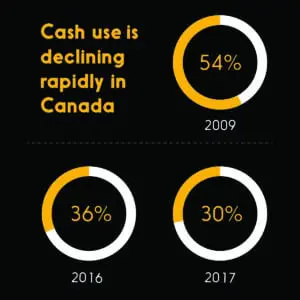Physical currency has been around for thousands of years, so it’s easy to see it as the default way to pay. But as the years have passed, that idea has become increasingly irrelevant. Canadians are turning to new methods to complete their daily purchases, and soon, cash may no longer be king. Here are just a few statistics that bear that point out.
Cash use is declining rapidly in Canada

The past decade has not been kind for cash. In 2009, the Bank of Canada’s Methods of Payment Study reported that when consumers paid in-person for a purchase, they used cash 54 per cent of the time. By 2017, that rate had fallen to 30 per cent of all in-person transactions, according to the Interac Payment Share Study, marking a steep decline. And since in-person payments accounted for 95 per cent of all purchases during that time, the drop is even more pronounced (the other five per cent of purchases were predominantly e-commerce and a small amount of phone transactions).
Contactless payments are on the rise…

So what’s driving this change? As cash transaction rates have fallen, contactless payments have continued to rise. In 2017, contactless payments were responsible for 28.5 per cent of all in-person purchases, a seven per cent increase from the previous year. In that same period, the share of cash transactions dropped by 6.6 per cent, which means that billions of transactions that were once completed with cash are now being done with contactless payment methods. And that becomes especially apparent when you delve into transactions under $10.
Cash is becoming less popular for smaller payments

Cash use has declined across the board, whether consumers are paying for something that costs six dollars or $200. But not all categories have been affected equally. The share of cash transactions in Canada decreased by 15 per cent in 2017 for purchases less than six dollars, and decreased by nine per cent for purchases between six and ten dollars. By contrast, every other purchase size measured saw declines of five per cent or less.
In each of these small transaction categories, the share of contactless payments made significant gains, rising by 12 per cent for purchases under six dollars and nine per cent in those under $10. It all goes to show that cash had better watch its throne, because when it comes to day-to-day purchases, contactless may soon be king.


